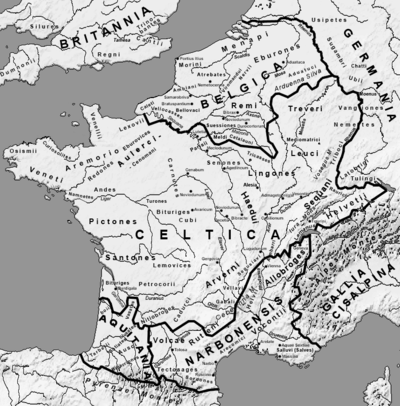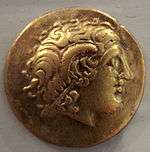Leuci
The Leuci (Gaulish: "the bright ones, the lightning ones") were a Belgic tribe, dwelling in the southern part of the modern Lorraine region during the Roman era.[1]
Name
They are mentioned as Leucos (acc.) by Caesar (mid-1st c. BC),[2] as Leūkoi (Λευ̃κοι) by Strabo (early 1st c. AD),[3] as Leuci by Pliny (1st c. AD),[4] and as Leukoì (Λευκοὶ) by Ptolemy (2nd c. AD).[5][6]
The name Leuci ('the bright ones, the lightning ones') stems from Gaulish leucos ('light, bright'), itself from Proto-Celtic *lowkos ('light, bright'; compare with Middle Irish luach 'glowing white', Middle Welsh llug 'eyesight, perception'), ultimately from Proto-Indo-European *leukós ('bright, shining'; compare with Latin lūx 'light', Greek leukós 'white', Tocharian lyūke 'light').[7][8]
Geography

Territory
The territory of the Leuci extended in the east and the south-east up to the Vosges moutains, between the Marne and Moselle rivers.[1] They were located north-west of the Sequani, and south-west of the Mediomatrici.[1]
Settlements
During the Roman era, their capital was Tullum (modern Toul).[9][1] Ptolemy (2nd c. AD), who normally gives one capital for each civitas, also lists Nasium (present-day Naix-aux-Forges) as a capital of the Leuci.[10]
Hillforts held by the Leuci included a large oppidum at Boviolles (Ornain valley) west of their territory, and some small ones in the Vosges. The Roman-era successor of Boviolles was more opposing that the capital Tullum, since the Ornain river was important trade route between Champagne and the plateau of Langres, on the territory of the Lingones. Another possible oppidum was located at Geneviève (Essey).[9]
Religion
During the Roman era, the Leuci worshipped Apollo (at Graux and Malaincourt), or Apollo Grannus (at Tullum, Nasium, and Grand), centred around a spring and healing cult.[1]
History
They are mentioned by Julius Caesar as a people supplying wheat to the Roman army in 58 BC, along with the Lingones and Sequani.[11]
See also
- Celtic camp at Bure (near Saint-Dié-des-Vosges)
References
- Schön 2006.
- Caesar. Commentarii de Bello Gallico, 1:40
- Strabo. Geōgraphiká, 4:3:4
- Pliny. Naturalis Historia, 4:106
- Ptolemy. Geōgraphikḕ Hyphḗgēsis, 2:9:7
- Falileyev 2010, p. entry 2138.
- Delamarre 2003, p. 200.
- Matasović 2009, p. 245.
- Wightman 1985, p. 32.
- Wightman 1985, p. 76.
- Gallic Wars, I.40
Bibliography
- Delamarre, Xavier (2003). Dictionnaire de la langue gauloise: Une approche linguistique du vieux-celtique continental (in French). Errance. ISBN 9782877723695.CS1 maint: ref=harv (link)
- Falileyev, Alexander (2010). Dictionary of Continental Celtic Place-names: A Celtic Companion to the Barrington Atlas of the Greek and Roman World. CMCS. ISBN 978-0955718236.
- Matasović, Ranko (2009). Etymological Dictionary of Proto-Celtic. Brill. ISBN 9789004173361.CS1 maint: ref=harv (link)
- Schön, Franz (2006). "Leuci". Brill's New Pauly.CS1 maint: ref=harv (link)
- Wightman, Edith M. (1985). Gallia Belgica. University of California Press. ISBN 978-0-520-05297-0.CS1 maint: ref=harv (link)

